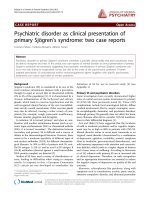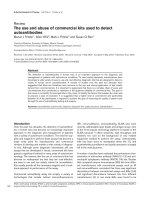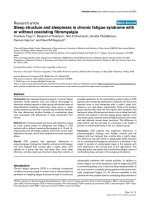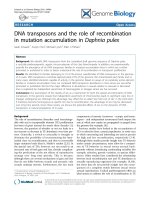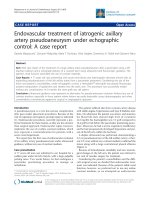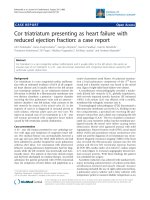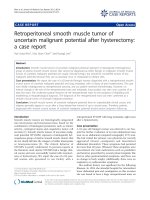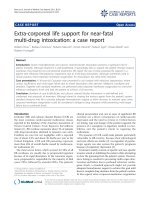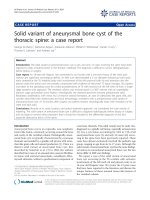Báo cáo y học: "Dermal reaction and bigeminal premature ventricular contractions due to neostigmine: a case repor" pdf
Bạn đang xem bản rút gọn của tài liệu. Xem và tải ngay bản đầy đủ của tài liệu tại đây (315.71 KB, 3 trang )
CAS E REP O R T Open Access
Dermal reaction and bigeminal premature
ventricular contractions due to neostigmine:
a case report
Fardin Yousefshahi
1*
, Mohammad Anbarafshan
2
, Patricia Khashayar
3
Abstract
Introduction: Neostigmine is a frequently used acetylcholinesterase inhibitor administered to reverse muscular
relaxation caused by nondepolarizing neuromuscular relaxants in patients recovering from general anesthesia.
Severe allergic reactions and urticari a are rarely reported following the use of neostigmine bromide, and never
with methylsulfate-containing drugs. In this case, bigeminal premature ventricular contractions added to urticaria
provides a warning about the possibility of a life-threatening situation.
Case presentation: We report the case of a 23-year-old Persian woman who presented with bigeminal premature
ventricular contractions along with urticarial lesions on her arm and trunk as soon as she was administered
neostigmine methylsulfate after undergoing a laparoscopy for ectopic pregnancy.
Conclusion: This case report could be of value not only for anesthesiologists who routinely use neostigmine but
also for others who administer the pharmaceutical preparation in other situations. The report presents a rare case
of drug reaction following neostigmine use. As a result, one should consider any drug a probable cause of drug
reaction. The preparation of resuscitative facilities, ther efore, is necessary prior to the prescription of the
medication.
Introduction
Neostigmine, generally used in combination with bro-
mide or methylsulfate, is an acetylcholine esterase inhi-
bitor prescribed mainly to reverse the effects of
muscular relaxants at the end of o perations performed
with the patient under general anesthesia. The drug is
also used in patients with myasthenia gravis and paraly-
tic ileus [1-3].
Increased saliva, nausea and v omiting, abdominal
cramps, cardiac dysrhythmia and diarrhea are the com-
monly reported side effects of the drug [4]. Severe aller-
gic reactions and urticaria, however, are rarely reported
following the use of neostigmine bromide, and never
with methylsulfate-containing drugs [5]. This article pre-
sents the case of a pregnant woman who developed a 5
mm wheal on her left forearm after receiving neostig-
mine during an operation.
Case presentation
The patient was a 23-year-old Persian woman who
weighed 60 kg. She underwent a laparoscopy at the
eighth week of gestation (G1Ab0L0) because of a right
adenexal mass and free liquid in her dorsal cul de sac
space.
Considering the patient’s medical record, there was no
evidence of any underlying diseases or positive history
of allergic reactions to food or drugs in her or her close
family. She had never undergone any operations before
and had no previous exposure to neostigmine. Addition-
ally, there was no positive finding in her medical history,
preoperative examinations and laboratory findings (com-
plete blood count, erythrocyte sedimentation rate, blood
urea nitrogen, creatinine and liver function tests).
Midazolam(2mg)andfentanyl(50μg) plus thio pen-
tal (5 mg/kg), atracurium (0.5 mg/kg) and lidocaine (1
mg/kg) were injected to induce anesthesia. The patient
received halothane (1.2 minimum alveolar concentra-
tion) and oxygen (100%) for anesthesia maintenance.
Two minutes before the surgical incision was performed,
* Correspondence:
1
Anesthesia and Critical Care Department, Women Hospital & Tehran Heart
Center, Tehran University of Medical Sciences, Tehran, Iran
Full list of author information is available at the end of the article
Yousefshahi et al. Journal of Medical Case Reports 2011, 5:83
/>JOURNAL OF MEDICAL
CASE REPORTS
© 2011 Yousefshahi et al; licensee BioMed Central Ltd. This is an Open Access article distributed unde r the terms of the Creative
Commons Attribution License (http ://creativecommons.org/licenses/by/2.0), which permits unrest ricted use, distribution, and
reproduction in any medium, provided the original work is properly cited.
25 μg fentanyl was injected; atracurium (0.15 mg/kg)
was then administered every 20 minutes during the
operation.
The surgeon suctioned about 500 ml of blood from
the patient’s abdominal cavity; no blood, however, was
transfused during the two-hour, 40-minute operation.
The patient’s vital signs were monitored throughout the
surgery, and no specific complication was reported.
At the end of the operation, the patient was still in a
deep anesthetic stage and did not respond to painful sti-
muli. Partial muscular force, however, was restored as
soon as the inhaled anesthesia was ceased; thereafter
neostigmine (0.04 mg/kg) and atropine (0.02 mg/kg)
were infused slowly. At this time, the patient developed
a 5 mm urticarial lesion along the vein course that
quickly spread over the left forearm. The erythematous
convex lesions spread in a geographical pattern but
were less severe in the neck and chest (Figure 1).
Bigeminate premature ventricular contractions (PVCs)
were also noted at the same time but disappeared spon-
taneously after a few minutes. It should be noted that
the patient’s heartbeat (80beats/min), blood pressure
(110/60 mmHg) and blood oxygen saturation (SpO
2
)
(98%) were all normal at this time, and there was no
sign of wheeze or other abnormal lung sounds in
auscultation.
Hydrocortisone (200 mg) was prescribed for the
lesions. The tracheal tube was removed as soon as the
patient became consc ious, and she was then transferred
to the recovery room. No other complications such as
the development of dermal lesions or cardiac dysrhyth-
mia were reported during the patient’ s hospitalization,
and she was discharged in good condition.
A sample of the prescribed neostigmine was sent to
the laboratory of the Pharmacology Faculty; further
analysis revealed the medication to be neostigmine
methylsulfate with 102.85% effective substance (in accor-
dance with USP30 reference) with no other additives.
The postsurgical echocardiography was reported to be
normal. A skin test performed a few months after the
operation revealed a 5 mm wheal and 7 mm flare after
the patient was exposed to neostigmine; such a reaction,
however, was not noted following the exposure to atro-
pine, normal saline and latex. Additionally, histamine
exposure was associated with the development of an 8
mm wheal and a 9 mm flare, suggestive o f a positive
dermal reactio n. It should be noted that the patient did
not agree to undergo additive complement component
C3 or C4 and antinuclear antibody tests.
Discussion
Drug reactions presenting as dermal lesions is not a
known phenomenon following the use of neostigmine,
particularly neostigmine methylsulfate. While the under-
lyi ng cause of urticaria following allergen exposure may
remain unclear in certain cases, the presence of active
components, preservatives or convey ing combinations
(parabens and aldeheids) are often considered the main
cause of drug-related urticaria.
In our case, the absence of any preservatives or con-
veying combinations in the specific compound, along
with the results of the performed skin test, supported
the hypothesis that the neostigmine molecule itself had
been the main cause of the reported allergic reaction.
Arrhythmia, especially PVCs, is common during
anesthesia, particularly during the intubation and extu-
bation time, when the blood anesthetic level is lightened
and the airway is stimulated. There are many other fac-
tors to take into account, including cardiac disease,
direct stimulation, toxins and allergens, contributing to
arrhythmia during surgery. PVCs are often benign and
reso lve spontaneously, but rarely are a precursor of life-
threatening arrhythmias.
In the present case, the patient was in deep stages of
anesthesia when the muscular block was reversed using
a combination of neostigmine and atropine. Considering
the fact that there was no noxious stimulation at the
very moment or minutes before that, the occurrence of
the lesion could be considered an obvious drug
eruption.
Conclusion
This case could be of value not only for anesthesiolo-
gists, as physicians who administer neostigmine routi-
nely, but also for others who are involved in
pharmaceutical preparation. The current report reveals
that neostigmine, similar to many other drugs, may
cause a drug reaction. Co-occurrence of bigeminate pre-
mature ventricular contractions, therefore, sho uld be
Figure 1 Urticaria lesions in the recovery room 30 minutes
after occurrence, when partial resolution is obvious.
Yousefshahi et al. Journal of Medical Case Reports 2011, 5:83
/>Page 2 of 3
viewed as a herald of possible hemodynamic or cardiac
catastrophes. Physicians should hence consider any
drugs as a probable cause of drug reaction and should
be prepared for necessary resuscit ative actions in case it
occurs.
Consent
Written informed consent was obtained from the patient
and her husband (in the respect of local customs) for
publication of this manuscript and accompanying
images. A copy of the written consent is available for
review by the Editor-in-Chief of this journal. At same
time, it should be noted that unfortunately the patient
did not agree to undergo C3, C4 and ANA tests.
Abbreviations
ANA: antinuclear antibody; C3: complement component 3; C4: complement
component 4; PVCs: premature ventricular contractions;
Acknowledgements
We express our gratit ude to Professor Abbas Kebriaeezadeh (Departments of
Toxicology, Faculty of Pharmacy, Tehran University of Medical Sciences) for
performing the pharmaceutical analysis of the neostigmine sample. Also, we
appreciate our patient and her husband for permitting and helping us in
presenting this case.
Author details
1
Anesthesia and Critical Care Department, Women Hospital & Tehran Heart
Center, Tehran University of Medical Sciences, Tehran, Iran.
2
Anesthesia and
Critical Care Department, Sina Hospital, Tehran University of Medical
Sciences, Tehran, Iran.
3
General Practitioner, Endocrinology and Metabolism
Research Center, Tehran University of Medical Sciences, Tehran, Iran.
Authors’ contributions
FY was the responsible anesthesiologist for the patient and scientific
coordinator in preparing the case report. MA was the responsible anesthesia
resident at the time of patient admission, he performed the following
laboratory and skin tests and evaluated their impact on the diagnosis. PK
performed searches and prepared the first version of the written case report.
All authors read and approved the final version of the manuscript.
Competing interests
The authors declare that they have no competing interests.
Received: 8 May 2010 Accepted: 25 February 2011
Published: 25 February 2011
References
1. Hunter JM: Is it always necessary to antagonize residual neuromuscular
block? Do children differ from adults? Br J Anaesth 1996, 77:707-709.
2. Fawcett WJ: Neuromuscular block in children. Br J Anaesth 1997, 78:627.
3. Fuchs-Buder T, Mencke T: Use of reversal agents in day care procedures
(With special reference to postoperative nausea and vomiting). Eur J
Anaesthesiol 2001, 18(Suppl 23):23-29.
4. Naguib M, Lien CA: Pharmacology of muscle relaxants and their
antagonists. In Textbook of Anesthesiology. Volume 1. 6 edition. Edited by:
Miller RD. Philadelphia: Elsevier; 2005:511-514.
5. Seed MJ, Ewan PW: Anaphylaxis caused by neostigmine. Anaesthesia 2000,
55:574-575.
doi:10.1186/1752-1947-5-83
Cite this article as: Yousefshahi et al.: Dermal reaction and bigeminal
premature ventricular contractions due to neostigmine: a case report.
Journal of Medical Case Reports 2011 5:83.
Submit your next manuscript to BioMed Central
and take full advantage of:
• Convenient online submission
• Thorough peer review
• No space constraints or color figure charges
• Immediate publication on acceptance
• Inclusion in PubMed, CAS, Scopus and Google Scholar
• Research which is freely available for redistribution
Submit your manuscript at
www.biomedcentral.com/submit
Yousefshahi et al. Journal of Medical Case Reports 2011, 5:83
/>Page 3 of 3

